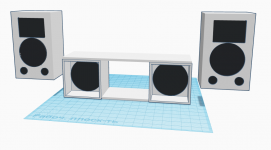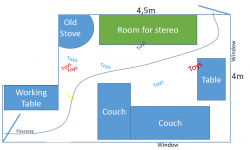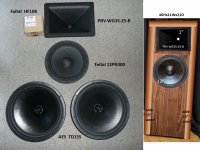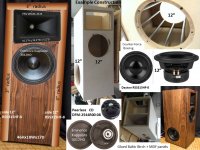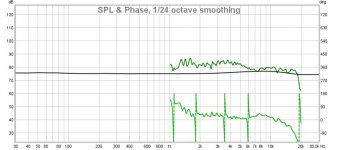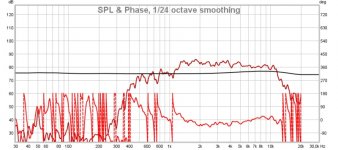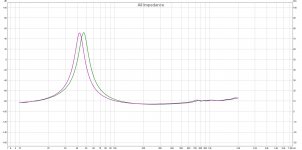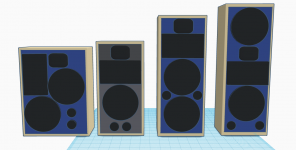Hi and thank you for reading this thread.
This is the continue of my previous topic, where during prototyping and listening I realized the initial concept did not fulfill my expectations. What I came up with while prototyping is 15” woofer for midbass in BR box and a horn tweeter.
4 way full scale home system
Just to repeat in short here, what I am looking for is a natural very dynamic sound which is as close as possible to live performance. I have some limitations, my room does not allow me to put in very big speakers. So fully horn system is not an option, I know some people were advising looking at horns. And I want to stay within a reasonable budget for this project.
What is for now decided:
1. 18” woofers for bass in H-frames. Beyma 18LX60. Will play 30-90 Hz. Very powerful PA amplifier to feed them. Will be integrated in a TV shelf, like a furniture piece.
2. 15” woofers for midbass, JBL k130 in about 100l BR box. This is the midbass I like most of all other woofers I tried. They can also play quite high, up to 1,5 kHz easily good enough for my ears.
It is not fully decided what will be used on top of that. I am currently having 2” Renkus Heinz drivers with horns, but they surely need a tweeter. After doing some studying and asking questions I was highly recommended to stay away from 3 way for the tops and stick to a driver which can play highs and does not need a tweeter. Inspired by econowave and 4pi concepts I am now willing to try the k130 with a 1” driver in a good constant directivity waveguide.
So I pulled a trigged on the QSC clone waveguide, which seems to have a good reputation:
B-52 PHRN-1014 1" Horn 10" x 14" Bolt-On
I am also about to order a pair of Faital HF108. Would be nice to hear opinions about those and if anyone used them with this horn.
Look forward for comments and opinions. Below a quick sketch how I see the system looking like.
This is the continue of my previous topic, where during prototyping and listening I realized the initial concept did not fulfill my expectations. What I came up with while prototyping is 15” woofer for midbass in BR box and a horn tweeter.
4 way full scale home system
Just to repeat in short here, what I am looking for is a natural very dynamic sound which is as close as possible to live performance. I have some limitations, my room does not allow me to put in very big speakers. So fully horn system is not an option, I know some people were advising looking at horns. And I want to stay within a reasonable budget for this project.
What is for now decided:
1. 18” woofers for bass in H-frames. Beyma 18LX60. Will play 30-90 Hz. Very powerful PA amplifier to feed them. Will be integrated in a TV shelf, like a furniture piece.
2. 15” woofers for midbass, JBL k130 in about 100l BR box. This is the midbass I like most of all other woofers I tried. They can also play quite high, up to 1,5 kHz easily good enough for my ears.
It is not fully decided what will be used on top of that. I am currently having 2” Renkus Heinz drivers with horns, but they surely need a tweeter. After doing some studying and asking questions I was highly recommended to stay away from 3 way for the tops and stick to a driver which can play highs and does not need a tweeter. Inspired by econowave and 4pi concepts I am now willing to try the k130 with a 1” driver in a good constant directivity waveguide.
So I pulled a trigged on the QSC clone waveguide, which seems to have a good reputation:
B-52 PHRN-1014 1" Horn 10" x 14" Bolt-On
I am also about to order a pair of Faital HF108. Would be nice to hear opinions about those and if anyone used them with this horn.
Look forward for comments and opinions. Below a quick sketch how I see the system looking like.
Attachments
Last edited:
A 15 + 1 system with subs. This seems to be similar to an econowave, so there are a jillion existing builds / threads you can refer to. This is good.
Test Bench - Faital Pro’s HF108/HF108R compression drivers coupled with LTH102 60deg x 50deg horn | audioXpress
The 3rd party tests look fine.
Test Bench - Faital Pro’s HF108/HF108R compression drivers coupled with LTH102 60deg x 50deg horn | audioXpress
The 3rd party tests look fine.
I use four Goldwood 1858 in Hframes in my setup... I'd be curious how only a pair of em sound using the 18lx60... Or how four would sound  For the money, you may be able to do a pair of PA460 per side... Either way, you want a higher QTS driver than 0.3... I've used 0.7-1.0 drivers and don't need EQ to dig deep. With low QTS, I don't think you'll get as low.
For the money, you may be able to do a pair of PA460 per side... Either way, you want a higher QTS driver than 0.3... I've used 0.7-1.0 drivers and don't need EQ to dig deep. With low QTS, I don't think you'll get as low.
Thanks for replies.
The attached picture represents the sad reality of my room configuration. I live in a very old house, which when was built people had other priorities in life than stereo and TV. For now there is no other option for a better room/place.
mortron, I am curious about how four of Goldwoods sound in your setup? What kind of amp do you use to power them? I heard that Q factor is not very important if speakers are crossed low, much below baffle step.
PA460 do not seem to be available in Europe anymore, I also considered them in the beginning.
etalon90, to be honest I have not yet tried the Beymas yet in H-frames, but I tried them free air with 800w in 8Ohm RMS amp and they can move some air. They have to sweat a bit, but this is what they are designed for. I would be happy if they play well in H-frames down to 40Hz. Now I have four 15” in open baffle and I like the bass (I cannot say the same about midbass though).
No, I cannot use another room as an enclosure, I have thought about that. Kid’s bedroom is coupled to both rooms on sides so it is not an option.
Considering my configuration what solution would you propose? I can increase the size of H-frames if this matters. Right now I am thinking about 450-500mm deep.
The attached picture represents the sad reality of my room configuration. I live in a very old house, which when was built people had other priorities in life than stereo and TV. For now there is no other option for a better room/place.
mortron, I am curious about how four of Goldwoods sound in your setup? What kind of amp do you use to power them? I heard that Q factor is not very important if speakers are crossed low, much below baffle step.
PA460 do not seem to be available in Europe anymore, I also considered them in the beginning.
etalon90, to be honest I have not yet tried the Beymas yet in H-frames, but I tried them free air with 800w in 8Ohm RMS amp and they can move some air. They have to sweat a bit, but this is what they are designed for. I would be happy if they play well in H-frames down to 40Hz. Now I have four 15” in open baffle and I like the bass (I cannot say the same about midbass though).
No, I cannot use another room as an enclosure, I have thought about that. Kid’s bedroom is coupled to both rooms on sides so it is not an option.
Considering my configuration what solution would you propose? I can increase the size of H-frames if this matters. Right now I am thinking about 450-500mm deep.
Attachments
That's a tough room to work with. I have been lucky to have rooms with enough depth to maintain at least 3ft between speakers and front wall. Pretty critical for OB IMO. If you got that, you're in good shape.
While I agree that the 18LX60 would be good, I can't help but feel that the cost tradeoff is another thing for me. Here that driver costs about $425cad and I paid less than that for my four Goldwoods total. Not sure what else is available to you guys over there for cheap in an 18. I'm jealous that you've got better prices on better stuff. Canada gets some good deals but the PE inventory and shipping prices make me wish I lived south of the border.
Regarding QTS, I think the benefit is that you're less likely to need EQ because the high QTS extends the low end, whereas a lower QTS driver would roll off sooner. The Beyma would be more suited to ported enclosure based on its QTS I think... but I could be wrong. You may have to EQ a bit to get a nice flat response. That's why I chose the Goldwoods... They had been shown to have a decent response for little outlay. No EQ needed or crazy XO (I was PLLXO then). Don't get me wrong.. I wish I had some Beyma 18s... But I'd put them in a box personally. With a pair of 15s in bass reflex, I'd be curious how the energy would change at XO. My mains are small, and worry that a large BR mid May have trouble mating well.
In regards to crossing over low... I believe the idea is that you're wanting to cross below baffle step? That would lower sensitivity in a way no? How high do you plan to take these? My Hframes are 16"deep total with baffle centered more or less. MJK has a design using this woofer and I believe the driver extends to 200hz with a 100hz crossover at 12db/LR2. He explains the reason for why you'd stick with a certain depth. It will go lower if deeper cavity but then the resonance becomes an issue nearer to XO.
My setup uses an Ashly XR2000 active crossover to split between my mains and Hframes. I presently run them about 90hz down. 100hz is a bit too much and starts to get muddy. Plus I probably run them a bit hot to compensate for the fact I like the thump they provide and the mains are monopole boxed speakers (JBL L5 - great bass but not compared to four 18's). Amps are changing but I've used a Denon POA2400, QSC mx1500a (regret selling), Crown XLS602 and a Crown XLS1500. All of them had no issues with the latter amps being able to really drive them. My woofers only have 2mm Xmax so I don't get them too loud but they get really loud before running out of steam. Wired for 4ohms now and having a blast without breaking a sweat. My mains amp gets hotter.
If you do not like the mid bass of the 15, you may not in an 18 either. I believe the Hframe causes resonance issues and above a certain frequency it begins to act up.
Not 100% on the explanations provided... I've just kind of developed a way of thinking around open baffles. Kind of like "stoves are hot". I can't explain the science very well, I just know enough to keep my hand off the burner lol. I measure with my ears until I can pony up dough for a mic... Fortunately I have other sets of ears to consult with... Kind of a dumb way to figure it out... But some days I think ignorance is bliss when it comes to frequency response hah.(it's not).
If in the end you do use the Beyma Inan Hframe... I hope you prove me wrong and can get some measurements. It'd be nice knowing there are other options down the road.
What makes this place great tho is that people try new things and expand the knowledgebase. I look forward to your project developing.
While I agree that the 18LX60 would be good, I can't help but feel that the cost tradeoff is another thing for me. Here that driver costs about $425cad and I paid less than that for my four Goldwoods total. Not sure what else is available to you guys over there for cheap in an 18. I'm jealous that you've got better prices on better stuff. Canada gets some good deals but the PE inventory and shipping prices make me wish I lived south of the border.
Regarding QTS, I think the benefit is that you're less likely to need EQ because the high QTS extends the low end, whereas a lower QTS driver would roll off sooner. The Beyma would be more suited to ported enclosure based on its QTS I think... but I could be wrong. You may have to EQ a bit to get a nice flat response. That's why I chose the Goldwoods... They had been shown to have a decent response for little outlay. No EQ needed or crazy XO (I was PLLXO then). Don't get me wrong.. I wish I had some Beyma 18s... But I'd put them in a box personally. With a pair of 15s in bass reflex, I'd be curious how the energy would change at XO. My mains are small, and worry that a large BR mid May have trouble mating well.
In regards to crossing over low... I believe the idea is that you're wanting to cross below baffle step? That would lower sensitivity in a way no? How high do you plan to take these? My Hframes are 16"deep total with baffle centered more or less. MJK has a design using this woofer and I believe the driver extends to 200hz with a 100hz crossover at 12db/LR2. He explains the reason for why you'd stick with a certain depth. It will go lower if deeper cavity but then the resonance becomes an issue nearer to XO.
My setup uses an Ashly XR2000 active crossover to split between my mains and Hframes. I presently run them about 90hz down. 100hz is a bit too much and starts to get muddy. Plus I probably run them a bit hot to compensate for the fact I like the thump they provide and the mains are monopole boxed speakers (JBL L5 - great bass but not compared to four 18's). Amps are changing but I've used a Denon POA2400, QSC mx1500a (regret selling), Crown XLS602 and a Crown XLS1500. All of them had no issues with the latter amps being able to really drive them. My woofers only have 2mm Xmax so I don't get them too loud but they get really loud before running out of steam. Wired for 4ohms now and having a blast without breaking a sweat. My mains amp gets hotter.
If you do not like the mid bass of the 15, you may not in an 18 either. I believe the Hframe causes resonance issues and above a certain frequency it begins to act up.
Not 100% on the explanations provided... I've just kind of developed a way of thinking around open baffles. Kind of like "stoves are hot". I can't explain the science very well, I just know enough to keep my hand off the burner lol. I measure with my ears until I can pony up dough for a mic... Fortunately I have other sets of ears to consult with... Kind of a dumb way to figure it out... But some days I think ignorance is bliss when it comes to frequency response hah.(it's not).
If in the end you do use the Beyma Inan Hframe... I hope you prove me wrong and can get some measurements. It'd be nice knowing there are other options down the road.
What makes this place great tho is that people try new things and expand the knowledgebase. I look forward to your project developing.
Last edited:
Antonfazer,
behind the wall (room for stereo)is leading to outside?
If yes, yes, IB won't work for you.
In this case, because of room acoustic, I would recommend 4 smaller sealed sub scattered thru the room. Quad 15" will move more air than dual 18" and will keep your room mode in check.
I would use one on each side of couch, one in the center where is your stereo and one nearby the stove. (bass is mono below 80hz so localization will be impossible anyway)
Marty
behind the wall (room for stereo)is leading to outside?
If yes, yes, IB won't work for you.
In this case, because of room acoustic, I would recommend 4 smaller sealed sub scattered thru the room. Quad 15" will move more air than dual 18" and will keep your room mode in check.
I would use one on each side of couch, one in the center where is your stereo and one nearby the stove. (bass is mono below 80hz so localization will be impossible anyway)
Marty
I have the Faital HF108 with the PRV-WG35-25 waveguide crossed with the MiniDSP BW3/BW3 filter at 1200Hz to a Faital 12PR300 midwoofer. I am very happy with the wide bandwidth sound. The long range plan is to add my two AES TD15S woofers for a complete 3-way, with a cabinet similar to the Tweek Geeks BMF-1.
Using DSP + separate amp can generate deep equalized bass from dual side-side 12" woofers in a modest 6cuft cabinet.
Using DSP + separate amp can generate deep equalized bass from dual side-side 12" woofers in a modest 6cuft cabinet.
Attachments
Mortron, I have the 18lx60 already, so I will go with them. I will use DSP and I will keep an inductor in series, which will increase Qt a bit. I managed to find a clean pair of 18lx60 rev.1, which seems to have better specs for OB in my opinion. Of course I will report about the results. So far I tried them in free air with 700+W amp and liked it so far. I am also aiming for 90Hz X-over frequency which is lower that baffle step.
As I understood MJK, his H-frame dimensions are limited (depth) due to crossing them quite high. For 90Hz X-over frequency it can be built much deeper.
My dislike of midbass of open baffle I think is caused by the open baffle itself, but not the size of a woofer. I heard several quite good OB and all of them sound to me like there is no “body” in the sound. This is why I will use BR for midbass. It is my personal observation and perhaps the matter of taste.
Etalon90, IB is not an option. The reason I stick to H-frames is that the best bass that I heard so far in my room was from OB. I think I have to try (perhaps prototype) them out and look for another solution if not successful. I do not have much believe in sealed box subs, I have not heard one yet which I really liked. Thanks for your advice anyway.
Maybe I could build multiple H-frame subs and attach them to the ceiling like lamps J
LineSource, very interesting, thank you. How does the HF108 measure in this waveguide? Suitable for passive X-over? How about dynamics and listening fatigue?
Puppet and Charles Darwin, I am aware of low Xmax and that is an instrumental speaker. However, to my taste this is the best mid-midbass I happened to hear so far. I am not concerned about Xmax. It will play 90Hz and higher in BR box, for that the cone of 15” barely moves on 110db. I rarely listen louder than 100 db.
K130 has a very light cone, 60g MMS. Alnico magnet, 4” aluminium wire coil. Real measured Qts of 0,35 which is excellent for BR. I have compared it to 2220, EVM12l and Faital 10fh520 and preferred the K130, see my first thread.
I think many people nowadays look and see high Xmax only as advantage, but forget about the cons. Speaker is always a compromise. I think I found several threads on this forum where people discussed 15” midwofers with particularly low X-max. After my experiments with midwoofers I realized that high Xmax is not an advantage for home use. This is my opinion and not valid for bass and subbass woofers though.
I have a second pair of K130 with wavy (defected) cones. I may try to recone them with hemp cones and use paper caps just for interest.
As I understood MJK, his H-frame dimensions are limited (depth) due to crossing them quite high. For 90Hz X-over frequency it can be built much deeper.
My dislike of midbass of open baffle I think is caused by the open baffle itself, but not the size of a woofer. I heard several quite good OB and all of them sound to me like there is no “body” in the sound. This is why I will use BR for midbass. It is my personal observation and perhaps the matter of taste.
Etalon90, IB is not an option. The reason I stick to H-frames is that the best bass that I heard so far in my room was from OB. I think I have to try (perhaps prototype) them out and look for another solution if not successful. I do not have much believe in sealed box subs, I have not heard one yet which I really liked. Thanks for your advice anyway.
Maybe I could build multiple H-frame subs and attach them to the ceiling like lamps J
LineSource, very interesting, thank you. How does the HF108 measure in this waveguide? Suitable for passive X-over? How about dynamics and listening fatigue?
Puppet and Charles Darwin, I am aware of low Xmax and that is an instrumental speaker. However, to my taste this is the best mid-midbass I happened to hear so far. I am not concerned about Xmax. It will play 90Hz and higher in BR box, for that the cone of 15” barely moves on 110db. I rarely listen louder than 100 db.
K130 has a very light cone, 60g MMS. Alnico magnet, 4” aluminium wire coil. Real measured Qts of 0,35 which is excellent for BR. I have compared it to 2220, EVM12l and Faital 10fh520 and preferred the K130, see my first thread.
I think many people nowadays look and see high Xmax only as advantage, but forget about the cons. Speaker is always a compromise. I think I found several threads on this forum where people discussed 15” midwofers with particularly low X-max. After my experiments with midwoofers I realized that high Xmax is not an advantage for home use. This is my opinion and not valid for bass and subbass woofers though.
I have a second pair of K130 with wavy (defected) cones. I may try to recone them with hemp cones and use paper caps just for interest.
As a next step I plan to recieve the hf108 and the waveguides and give them a try out with active crossover. In case I like the sound I will proceed with building cabinets.
Right now one of the open questions for me is how to protect the K130 from kids. The grills I can find for 15" resonate quite much and are ugly. Does anyone have any suggestion?
Right now one of the open questions for me is how to protect the K130 from kids. The grills I can find for 15" resonate quite much and are ugly. Does anyone have any suggestion?
Antonfazer,
I understand the Hframe appeal
HFrame, like IB, doesn't "air load" the driver and sound great. (I had OB before moving to a full IB system and eventually horn)
Sealed box create internal pressure and driver has to fight hard against it.
IB doesn't suffer from cancellation and required power remain constant.
"Hframe" will need "reverse linkwitz transform" to keep output linear and distortion will increase a lot as a result (thermal compression and extra Xmax required for same spl )
I have done a comparison between my 18" in IB and the very same driver in a ~4CF sealed box (Qtc of 0.7)
Distortion increase 6 FOLD and this is at moderate SPL!!!
Subjectively, it's not the same either...
With sealed, you need many boxes.
infinite baffle system advantge, subwoofer in IB are best
I would use many HFrame if you can. 4 Minimum as those will require heavy EQ to get flat result and you may run out of Xmax quick at LF.
Make sure you spread them thru the room (as your first idea, centered in the middle of the stereo eqpt, acoustically, it's almost the worst case scenario)
Read about multiple subwoofer and general room acoustic.
YMMV
I understand the Hframe appeal
HFrame, like IB, doesn't "air load" the driver and sound great. (I had OB before moving to a full IB system and eventually horn)
Sealed box create internal pressure and driver has to fight hard against it.
IB doesn't suffer from cancellation and required power remain constant.
"Hframe" will need "reverse linkwitz transform" to keep output linear and distortion will increase a lot as a result (thermal compression and extra Xmax required for same spl )
I have done a comparison between my 18" in IB and the very same driver in a ~4CF sealed box (Qtc of 0.7)
Distortion increase 6 FOLD and this is at moderate SPL!!!
Subjectively, it's not the same either...
With sealed, you need many boxes.
infinite baffle system advantge, subwoofer in IB are best
I would use many HFrame if you can. 4 Minimum as those will require heavy EQ to get flat result and you may run out of Xmax quick at LF.
Make sure you spread them thru the room (as your first idea, centered in the middle of the stereo eqpt, acoustically, it's almost the worst case scenario)
Read about multiple subwoofer and general room acoustic.
YMMV
Last edited:
I feel it is time to update the thread with my latest observations.
I received QSC clone 1” waveguides and Faital HF108R drivers. In a few hours I was already trying them out in a 2-way with my selected JBL K130 midbass woofers. Faital drivers from the start showed good dynamics, excellent details and impression of little or no listening fatigue. I liked them.
My first attempt was to have a crossover point around 1200 Hz with 3rd order crossovers and with this configuration I was not very impressed with the sound. It was dull and lifeless. The HF108R could perform well without noticeable distortion on the waveguide this low, but it just did not sound good. Then I tried different crossover points and the one I liked best in 2-way appeared to be around 2200 Hz. Having a 15” woofer playing this high brought a lot of dynamics and life into the sound. In fact, I was truly impressed with this combination, especially the dynamics. Overdriven guitars sounded awesome and very natural on any record I played. Like listening to a guitar cab. By itself it is already a great indicator and an achievement for me.
The next day I built a rig with both, the HF108R on QSC and the Renkus Heinz 3301 2” driver to try the system in 3-way. For now of course I used a DSP and active filtering to achieve smooth response. I also made two presets in the DSP so I could switch between 2-way and 3-way directly. So I ran an A-B test comparing the 2-way and 3-way.
The 2-way config: the JBL K130 60 to 2200 Hz, BW 18 order filter, some EQ on 800-1000Hz. On top the Faital HF108R on QSC clone, BW 18 order filter, 2400 Hz and up, EQ on 3-6k. Speakers in the same polarity, no delays.
The 3-way config: the JBL K130 60 to 1400 Hz, BW 18 order filter, some EQ on 800-1000Hz. Midrange: Renkus Heinz 3301 on Renkus 820 horn, 1600 to 3500 Hz. On top the Faital HF108R on QSC clone, BW 18 order filter, 4000 Hz and up, EQ on 4-6k. The midrange horn in reversed polarity being on a longer horn, no delays.
I dedicated about 14 hours listening to this mono setup. Different styles, recordings; switching between configs continuously. To sum up my audition experience, the 2-way kills with the dynamics. I got impressed with every new song. Especially liked the way guitars sounded. The cons: the sound gets too sterile like studio headphones and after a while I got a little tired listening. After switching from 2 to 3-way, this comes to mind: “Wow, the 2-way is awesome, but the 3-way is the one I would keep at home for myself”. The three way really brings even more life into music, it becomes more 3-dimentional. Even though it lacks a bit of dynamics, it is much more musical and triggers more emotions when listening. For me this appears to be important. I got to know an interesting expression today, it sounds something like: “Art can be evaluated by the amount and quality of emotions a person gets while experiencing the art”. Based on that, the 3-way config is a sure win for me.
So I finally decided to go 3-way for the top-speakers, a 15” midbass and two compression drivers with 2” and 1” throat. The horn I used during auditions for the 2” is not a good option for home use due to multiple slots. So I ordered and already received a pair of 18"x10” ebay horns discussed here to be good for home use. I also ordered a pair of 18 sound XT120 horns since I do not need the Faital driver to play low. I have much hope for this combination and this time almost sure I will proceed with them to final build.
More auditions to be made next week when I get the small horns.
I received QSC clone 1” waveguides and Faital HF108R drivers. In a few hours I was already trying them out in a 2-way with my selected JBL K130 midbass woofers. Faital drivers from the start showed good dynamics, excellent details and impression of little or no listening fatigue. I liked them.
My first attempt was to have a crossover point around 1200 Hz with 3rd order crossovers and with this configuration I was not very impressed with the sound. It was dull and lifeless. The HF108R could perform well without noticeable distortion on the waveguide this low, but it just did not sound good. Then I tried different crossover points and the one I liked best in 2-way appeared to be around 2200 Hz. Having a 15” woofer playing this high brought a lot of dynamics and life into the sound. In fact, I was truly impressed with this combination, especially the dynamics. Overdriven guitars sounded awesome and very natural on any record I played. Like listening to a guitar cab. By itself it is already a great indicator and an achievement for me.
The next day I built a rig with both, the HF108R on QSC and the Renkus Heinz 3301 2” driver to try the system in 3-way. For now of course I used a DSP and active filtering to achieve smooth response. I also made two presets in the DSP so I could switch between 2-way and 3-way directly. So I ran an A-B test comparing the 2-way and 3-way.
The 2-way config: the JBL K130 60 to 2200 Hz, BW 18 order filter, some EQ on 800-1000Hz. On top the Faital HF108R on QSC clone, BW 18 order filter, 2400 Hz and up, EQ on 3-6k. Speakers in the same polarity, no delays.
The 3-way config: the JBL K130 60 to 1400 Hz, BW 18 order filter, some EQ on 800-1000Hz. Midrange: Renkus Heinz 3301 on Renkus 820 horn, 1600 to 3500 Hz. On top the Faital HF108R on QSC clone, BW 18 order filter, 4000 Hz and up, EQ on 4-6k. The midrange horn in reversed polarity being on a longer horn, no delays.
I dedicated about 14 hours listening to this mono setup. Different styles, recordings; switching between configs continuously. To sum up my audition experience, the 2-way kills with the dynamics. I got impressed with every new song. Especially liked the way guitars sounded. The cons: the sound gets too sterile like studio headphones and after a while I got a little tired listening. After switching from 2 to 3-way, this comes to mind: “Wow, the 2-way is awesome, but the 3-way is the one I would keep at home for myself”. The three way really brings even more life into music, it becomes more 3-dimentional. Even though it lacks a bit of dynamics, it is much more musical and triggers more emotions when listening. For me this appears to be important. I got to know an interesting expression today, it sounds something like: “Art can be evaluated by the amount and quality of emotions a person gets while experiencing the art”. Based on that, the 3-way config is a sure win for me.
So I finally decided to go 3-way for the top-speakers, a 15” midbass and two compression drivers with 2” and 1” throat. The horn I used during auditions for the 2” is not a good option for home use due to multiple slots. So I ordered and already received a pair of 18"x10” ebay horns discussed here to be good for home use. I also ordered a pair of 18 sound XT120 horns since I do not need the Faital driver to play low. I have much hope for this combination and this time almost sure I will proceed with them to final build.
More auditions to be made next week when I get the small horns.
Hi and thanks for reading my thread.
It is time to report something interesting and not just text. I finally got all I need to proceed with the design. I received the ZXPC 2” horn:
2" Throat Horn Bolt-On 18"x10"For Assorted Bolt On 2"Exit Drivers 90degx 40deg(398) | eBay
And also the 18 sound XT120 small horn for the HF108R driver.
Below is the measurement of the Renkus-Heinz 3301 on the ZXPC horn, 1,5 meter. The driver is connected with 15uf capacitor in series and a 16 ohm L-pad. I plan to use it in the range of 1,3-1,5 to 6 kHz and I think it measures quire well there.
The other graph is the HF108R on XT120 connected with 10uf capacitor in series and a 16 ohm L-pad. Will be used from 6-7 kHz and above. Quite a sharp crossover will be needed, most probably 4th order, but apart of that it looks quite good as well.
One problem I have to deal with is a time alignment between the mid driver and the tweeter. Now when prototyping it with active crossover I tried to connect the tweeter in different polarity and neither option works well because drivers are about 100 offset being mounted on the same front panel. To mount the tweeter another way with this horn I do not see as a suitable option.
It is time to report something interesting and not just text. I finally got all I need to proceed with the design. I received the ZXPC 2” horn:
2" Throat Horn Bolt-On 18"x10"For Assorted Bolt On 2"Exit Drivers 90degx 40deg(398) | eBay
And also the 18 sound XT120 small horn for the HF108R driver.
Below is the measurement of the Renkus-Heinz 3301 on the ZXPC horn, 1,5 meter. The driver is connected with 15uf capacitor in series and a 16 ohm L-pad. I plan to use it in the range of 1,3-1,5 to 6 kHz and I think it measures quire well there.
The other graph is the HF108R on XT120 connected with 10uf capacitor in series and a 16 ohm L-pad. Will be used from 6-7 kHz and above. Quite a sharp crossover will be needed, most probably 4th order, but apart of that it looks quite good as well.
One problem I have to deal with is a time alignment between the mid driver and the tweeter. Now when prototyping it with active crossover I tried to connect the tweeter in different polarity and neither option works well because drivers are about 100 offset being mounted on the same front panel. To mount the tweeter another way with this horn I do not see as a suitable option.
Attachments
I did another experiment that some of you may find interesting. Out of my collection of JBL K130’s there was one with a good cone, but some imperfections on the dust cap. I have decided to replace the dust cap with a paper dust cap. So below are some pictures of the process.
The frequency response of the speaker before and after upgrade is almost identical up till 1,5-2 k, where the paper dust cap starts to roll of naturally while the aluminum cap extends up to 6-7 k. The advantage of the paper cap for my application is the smoother response, less resonances on the highs and easier crossover integration.
The drawback is however that the paper cap is a few grams heavier, which together with added glue resulted in 5-10 gram MMS increase; Fs has dropped 5-10 Hz. When it comes to listening impressions, the paper cap definitely makes the speaker to sound smoother and easier to integrate, but on the other hand more dull and lifeless. The “live” and dynamic feeling I was fond of in the K130 was partially gone with the paper cap.
I will try to upload TS parameters of the K130 with aluminum and paper dust caps as well as impedance curves later today.
The frequency response of the speaker before and after upgrade is almost identical up till 1,5-2 k, where the paper dust cap starts to roll of naturally while the aluminum cap extends up to 6-7 k. The advantage of the paper cap for my application is the smoother response, less resonances on the highs and easier crossover integration.
The drawback is however that the paper cap is a few grams heavier, which together with added glue resulted in 5-10 gram MMS increase; Fs has dropped 5-10 Hz. When it comes to listening impressions, the paper cap definitely makes the speaker to sound smoother and easier to integrate, but on the other hand more dull and lifeless. The “live” and dynamic feeling I was fond of in the K130 was partially gone with the paper cap.
I will try to upload TS parameters of the K130 with aluminum and paper dust caps as well as impedance curves later today.
Attachments
-
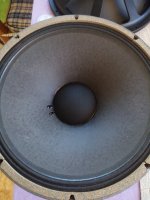 IMG_20190130_134608.jpg333 KB · Views: 59
IMG_20190130_134608.jpg333 KB · Views: 59 -
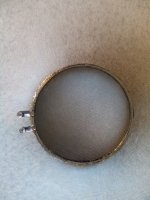 IMG_20190130_134602.jpg357.7 KB · Views: 58
IMG_20190130_134602.jpg357.7 KB · Views: 58 -
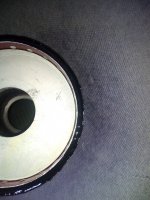 IMG_20190127_124355.jpg343.4 KB · Views: 53
IMG_20190127_124355.jpg343.4 KB · Views: 53 -
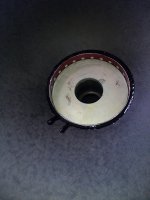 IMG_20190127_124337.jpg312.5 KB · Views: 57
IMG_20190127_124337.jpg312.5 KB · Views: 57 -
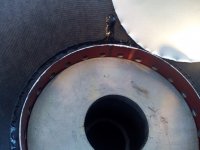 IMG_20190127_123416.jpg311 KB · Views: 53
IMG_20190127_123416.jpg311 KB · Views: 53 -
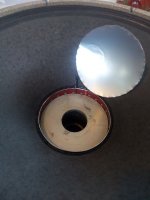 IMG_20190127_123407.jpg270.3 KB · Views: 367
IMG_20190127_123407.jpg270.3 KB · Views: 367 -
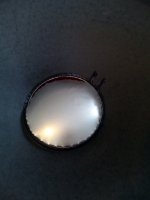 IMG_20190127_122946.jpg270.6 KB · Views: 371
IMG_20190127_122946.jpg270.6 KB · Views: 371 -
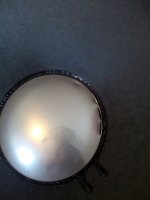 IMG_20190127_120311.jpg213.1 KB · Views: 385
IMG_20190127_120311.jpg213.1 KB · Views: 385
Thanks for update, any feedback/experience is always good to read.
Similar to your choice, I'm yet to hear a 2 way that I would want to own.
For your dynamic, have you considered 2x 15" ?
I'm using dual 15" myself and from single 15", the improvement was greatly noticeable. Soon to go to 4x 15", hopefully, the money spent was worth it.
Also, you may want to try lower point for the HF108 (~3.5, 4k) and cross the 2" RH accordingly. This is what I prefer in my setup (with 2"+1" and different CD/Horn combo)
Since you're on DSP, the try is easy and quick to test.
LAter
Similar to your choice, I'm yet to hear a 2 way that I would want to own.
For your dynamic, have you considered 2x 15" ?
I'm using dual 15" myself and from single 15", the improvement was greatly noticeable. Soon to go to 4x 15", hopefully, the money spent was worth it.
Also, you may want to try lower point for the HF108 (~3.5, 4k) and cross the 2" RH accordingly. This is what I prefer in my setup (with 2"+1" and different CD/Horn combo)
Since you're on DSP, the try is easy and quick to test.
LAter
In the attachment there is an impedance curves of the k130 with stock aluminium cap (green) and paper can (pink).
As promised, TS parameters for both:
K130 Paper cap:
fs 42.4 Hz
Qms 4.276
Qes 0.390
Qts 0.358
Fts 118.6
Mms 60.32 g
Cms 0.233 mm/N
Rms 3.759 kg/s
Vas 256.39 litres
Bl 16.108 Tm
Eta 4.89 %
Lp (1W/1m) 99.06 dB
K130 Aluminium cap:
fs 46.6 Hz
Qms 3.991
Qes 0.364
Qts 0.334
Fts 139.4
Mms 49.69 g
Cms 0.235 mm/N
Rms 3.641 kg/s
Vas 258.41 litres
Bl 15.853 Tm
Eta 6.99 %
Lp (1W/1m) 100.60 dB
As promised, TS parameters for both:
K130 Paper cap:
fs 42.4 Hz
Qms 4.276
Qes 0.390
Qts 0.358
Fts 118.6
Mms 60.32 g
Cms 0.233 mm/N
Rms 3.759 kg/s
Vas 256.39 litres
Bl 16.108 Tm
Eta 4.89 %
Lp (1W/1m) 99.06 dB
K130 Aluminium cap:
fs 46.6 Hz
Qms 3.991
Qes 0.364
Qts 0.334
Fts 139.4
Mms 49.69 g
Cms 0.235 mm/N
Rms 3.641 kg/s
Vas 258.41 litres
Bl 15.853 Tm
Eta 6.99 %
Lp (1W/1m) 100.60 dB
Attachments
etalon90, thanks for your comments. As for crossover points in my first configuration I found 4k to also be a better option, but with these particular horns it sounded better when I moved crossover frequency a bit up. For now it is just preliminary checks, bus as I build actual cabinets I plan more advanced auditions and measurements.
I also thought about 2x15” right after I changed the cap. I actually have a spare pair of speakers to do this. However, I cannot find a good solution how to combine it in one box without sacrificing directivity and the center of listening point, which in my case should be about 900mm above the floor. See attached examples.
I also thought about 2x15” right after I changed the cap. I actually have a spare pair of speakers to do this. However, I cannot find a good solution how to combine it in one box without sacrificing directivity and the center of listening point, which in my case should be about 900mm above the floor. See attached examples.
Attachments
I whish I could comment but my experience on bass bin is very limited.
I had the 3rd down from your picture (tmww) and it worked best
-Mostly due to spread floor reflection giving me 2 different cancellation frequency
Angling the bass bin backward so each woofer distance to my ear is the same reduced the C-T-C peak cancellation considerably but didn't removed it completely.
Ideally, crossover shall be 250hz or less but I have 4 ways already and have to accept tradeoff...
On it's side, it was worst on all aspect and it's the way my bassbin sit right now...
T
M
WW
My 4x15" bass bin will be diamond pattern
M
T
W
WW
w
So I hope it will "maximise" the smoothness of the floor bounce cancellation.
I'll also angle the bassbin inward.
Keep a eye on my site in my signature, I'll update it once the bassbin are playing
I had the 3rd down from your picture (tmww) and it worked best
-Mostly due to spread floor reflection giving me 2 different cancellation frequency
Angling the bass bin backward so each woofer distance to my ear is the same reduced the C-T-C peak cancellation considerably but didn't removed it completely.
Ideally, crossover shall be 250hz or less but I have 4 ways already and have to accept tradeoff...
On it's side, it was worst on all aspect and it's the way my bassbin sit right now...
T
M
WW
My 4x15" bass bin will be diamond pattern
M
T
W
WW
w
So I hope it will "maximise" the smoothness of the floor bounce cancellation.
I'll also angle the bassbin inward.
Keep a eye on my site in my signature, I'll update it once the bassbin are playing
- Status
- This old topic is closed. If you want to reopen this topic, contact a moderator using the "Report Post" button.
- Home
- Loudspeakers
- Multi-Way
- 3 way full scale home system, pt.II
